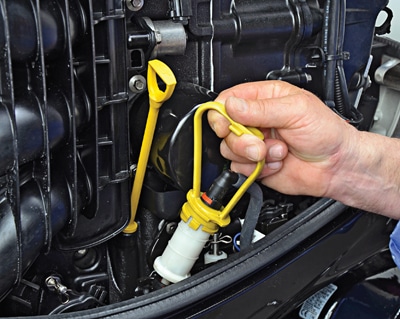Mercury’s new 150 FourStroke is an outboard for the times, designed to be affordable, rugged, durable and especially adaptable for repowering. This 3.0-liter, four-cylinder outboard offers more displacement than any other 150, and at 455 pounds (in 20-inch shaft length) it’s the lightest four-stroke 150 by at least 19 pounds. It uses cable controls and requires minimal maintenance. Its $12,980 suggested retail price is $2,550 less than the popular Yamaha F150, an engine Mercury used as its benchmark in its development of the 150 FourStroke.
The 150 FourStroke fills a gap Mercury made when it created the supercharged Verado 150 ($13,900), a 510-pound motor that’s heavy for the class and requires SmartCraft DTS digital control that costs $1,326, double the price of a standard cable control and harness. Mercury also offers its direct-injection two-stroke OptiMax 150 ($12,500), a bulkier V-6.
I trialed the 150 FourStroke on a Lund 1800 Fisherman with three adults aboard. Because this was a preproduction motor, I won’t report performance data, but my seat-of-the-pants impression was positive. Operation was smooth and quiet. I could have a normal conversation at cruising speed with the motor just six feet away. The new 150 FourStroke planed this boat smartly and still pulled a 16-pitch Enertia prop to 5,800 rpm. Its midrange is strong for a four-stroke, but I don’t think it can match the instant burst of thrust delivered by the supercharged Verado.
Durability is one reason Merc went with a generous 3.0-liter displacement, 12 percent larger than the 2.7-liter Yamaha’s. Displacement enhances torque and allows the engine to make peak power with less stress, according to Mercury. A single overhead cam shaft is driven by a maintenance-free chain running in an oil bath below the power head. Honda and Suzuki also use a chain. Yamaha uses a timing belt. All other 150 four-strokes have a four-valve, double overhead cam cylinder head. Merc says its single cam shaft and two-valve head is lighter, more compact and less complex. The valves are actuated with finger roller followers that require no valve-lash adjustment. A new gear-case housing is 4.9 inches in diameter, slightly larger than the Verado or OptiMax housing, which Mercury says makes room for stronger gears than are used on those models. The exhaust manifold is a smooth, free-flowing die-cast part that bypasses the adapter plate, so less heat is passed back into the engine oil and coolant.

Mercury worked hard to slim down its new FourStroke model. The single-cam head helps in that regard, but Merc made what I think is a clever move when it rotated the power head 11 degrees to port so it fits more neatly into the pan and cowl — filling the corners, as it were. This rotation also created space for a compact, scroll-shape intake manifold that fits on the aft starboard corner of the power head. Finally, rather than form the cowl as a one-piece “bucket,” Mercury uses a lightweight composite to form multiple parts that are then bonded together to form a cowl that is as compact as possible. It secures with a single latch and is easy to install.
Mercury knows you don’t read the owner’s manual, so it has placed key maintenance information on a label located right on the power head. That label will also have a “QR” code that can be scanned with a smartphone, linking it to videos that will show the boat owner DIY tasks, such as how to change the oil. That job is less messy thanks to a new oil-drain fitting that has a nipple for a drain hose and opens with a half-turn of a wrench, like a brake bleeder fitting. A big, yellow handle makes it easy to fish the fuel filter up from the pan, and quick-disconnect fittings make it a snap to change the filter without tools. This motor is permanently lubed, which means there are no grease fittings to service. If you can change the gear-case lube (just watch the video), you can probably do your own annual service.
In the 150 outboard segment, value matters as much as performance. The Mercury 150 FourStroke hits that target with a low price, minimal maintenance that’s DIY friendly, and a durable design that should keep it, and you, on the water for many seasons.
Key Features
1. Exhaust manifold with free-flowing runners keeps the engine cooler.
2. Composite intake scrolls around like a snail shell to increase runner length and, thus, torque.
3. Large label puts maintenance information right on the motor, with a QR tag for watching how-to videos on a smartphone.
Mercury 150 FourStroke
Engine type: 4-cylinder SOHC 4-stroke EFI
Displacement: 183 cid/3,000 cc
Bore x stroke (in./mm): 4.0 x 3.6/102 x 92
Max rpm: 5,000 to 6,000
Fuel requirement: 87 octane
Dry weight: 455 lb.
Alternator output: 60 amp
Gear ratio: 1.92:1
Shaft length: 20/25 in.









